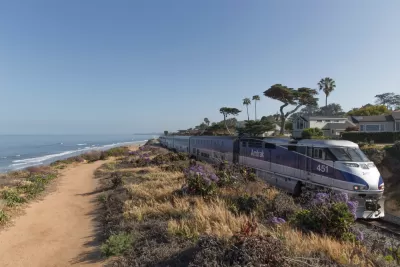A red-eye between Los Angeles and the San Francisco Bay Area could make train travel a viable options for millions of Californians.

As Amtrak plans to “add and enhance” routes around the country thanks to new federal funding, Bill Buchanan argues in favor of a Los Angeles-to-San Francisco over night train, an option not available to California train riders since 1983 that could transform travel between California’s most populous regions.
“Dedicated overnight trains, or the equivalent of red-eye flights, are uncommon in the U.S.,” Buchanan writes. “Amtrak has at least one, between Boston and Washington on the Northeast Corridor, although the sleeping car added to that train last year isn’t operating at present.”
Travel consultants say a Bay Area-to-Los Angeles train would need a comfortable lounge and sleeper cars, WiFi, and a dining car. Reasonably priced tickets would also draw riders if they can avoid the cost of gas or hotel rooms. “The state would have to do a lot of work before it could bring back an overnight train,” including agreement with the Union Pacific over track sharing, equipment availability, and more.
According to the article, “the state rail plan declares that California, by 2040, should have a system broad enough to attract 1.3 million rail riders per day, or ‘three times the number of passengers boarding flights at California’s seven largest airports … [the equal] of nearly 3,000 Boeing 747 jumbo jets.’” An L.A.-to-Bay Area red eye, Buchanan believes, would be a popular option for many riders.
FULL STORY: A red-eye train between LA and SF is a no-brainer for California travel — why don't we have the option?

Alabama: Trump Terminates Settlements for Black Communities Harmed By Raw Sewage
Trump deemed the landmark civil rights agreement “illegal DEI and environmental justice policy.”

Study: Maui’s Plan to Convert Vacation Rentals to Long-Term Housing Could Cause Nearly $1 Billion Economic Loss
The plan would reduce visitor accommodation by 25% resulting in 1,900 jobs lost.

Planetizen Federal Action Tracker
A weekly monitor of how Trump’s orders and actions are impacting planners and planning in America.

Waymo Gets Permission to Map SF’s Market Street
If allowed to operate on the traffic-restricted street, Waymo’s autonomous taxis would have a leg up over ride-hailing competitors — and counter the city’s efforts to grow bike and pedestrian on the thoroughfare.

Parklet Symposium Highlights the Success of Shared Spaces
Parklets got a boost during the Covid-19 pandemic, when the concept was translated to outdoor dining programs that offered restaurants a lifeline during the shutdown.

Federal Homelessness Agency Places Entire Staff on Leave
The U.S. Interagency Council on Homelessness is the only federal agency dedicated to preventing and ending homelessness.
Urban Design for Planners 1: Software Tools
This six-course series explores essential urban design concepts using open source software and equips planners with the tools they need to participate fully in the urban design process.
Planning for Universal Design
Learn the tools for implementing Universal Design in planning regulations.
Caltrans
Smith Gee Studio
Institute for Housing and Urban Development Studies (IHS)
City of Grandview
Harvard GSD Executive Education
Toledo-Lucas County Plan Commissions
Salt Lake City
NYU Wagner Graduate School of Public Service





























